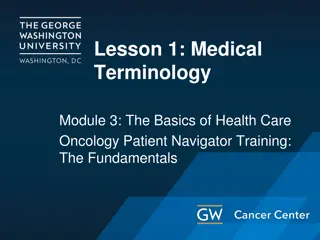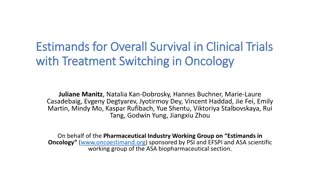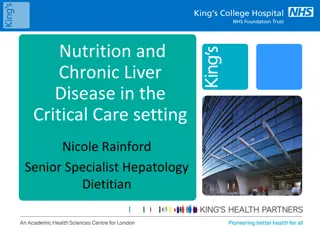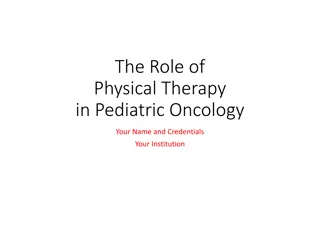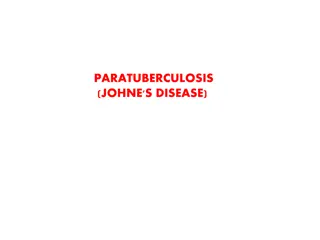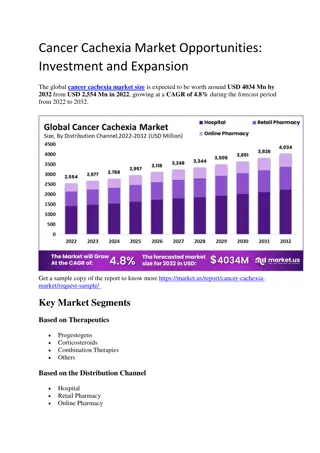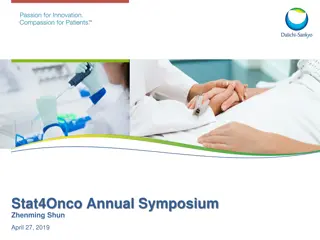Understanding Sarcopenia and Cachexia in Oncology
Sarcopenia and cachexia are prevalent issues in oncology, leading to muscle wasting, involuntary weight loss, and functional impairment. These conditions have various causes such as low energy intake, tumor treatments, inflammation, malnutrition, and infections. They can result in decreased quality of life, increased complications, and higher healthcare costs. Assessing nutritional status and physical activity levels through clinical parameters and screening tools is crucial for managing these conditions effectively.
Download Presentation

Please find below an Image/Link to download the presentation.
The content on the website is provided AS IS for your information and personal use only. It may not be sold, licensed, or shared on other websites without obtaining consent from the author. Download presentation by click this link. If you encounter any issues during the download, it is possible that the publisher has removed the file from their server.
E N D
Presentation Transcript
Sarcopenia & Cachexia In Oncology ESDO Learning Bytes 2021 Claire Gallois, MD Department of Digestive Oncology H pital Europ en Georges Pompidou Paris, France
DISCLOSURES AMGEN SERVIER SANOFI
Scope of the problem Sarcopenia= low lean body mass; fatigue is common, strength may be lessened, and physical function limited. Decrease in energy intake Tumour Sarcopenia Treatments Inflammation/hypercatabolism Malnutri tion Cachexia Infections Reduction in activity Cachexia=multifactorial wasting syndrome characterized by involuntary weight loss with ongoing loss of skeletal muscle mass with or without loss of fat mass; such wasting cannot be reversed by conventional nutrition care and may lead to functional impairment Fearon et al., Nat Rev Clin oncol 2014 Arend et al. Clinical Nutrition 2017
Sarcopenia/Malnutrition in Oncology Multifactorial inflammatory and hypercatabolic syndrome++ digestive strictures Cholestasis exocrine pancreatic insufficiency / diabetes (pancreatic cancer) Anxiety/depression Surgery/chemotherapy/radiotherapy (nausea, vomiting, mucositis, diarrhea, loss of appetite...) Consequences Impaired quality of life Decreased overall survival Increased risk of post-operative complications Increased risk of chemotherapy / radiotherapy toxicities Increased risk of infectious complications Increase in hospital stay and care costs Fearon et al., Nat Rev Clin oncol 2014 Arend et al. Clinical Nutrition 2017 (ESPEN guidelines)
Assessment of nutritional status/physical activity level: in clinical practice Clinical parameters Malnutrition Severe Malnutrition Weight loss In 1 month > 5% >10% In 6 months or compared to to usual weight before the onset of the disease > 10% >15% Non- consensual definitions BMI (kg/m2) < 70 years < 18.5 < 17 70 years < 21 < 18 Weight can be overestimated in case of edema, ascites measurement of brachial muscle circumference can be useful Ingesta Verbal/Visual Analogue Scale (threshold 7) +/- validated nutrition screening tools: NRS-2002, MUST, MST, MNA (for elderly patients) Initial screening and regular follow-up during treatment +++
Assessment of nutritional status/physical activity level: in clinical practice Clinical parameters Assessment of physical activity level ECOG- Performance status Fatigue Visual Analogue Scale +/- Handgrip test Repeated chair rise test (threshold: 5 rises > 14 seconds). Walking speed over 4 m heart rate and blood pressure after 5 minutes of lying down 6-minute walk test Get up and go test Bipodal and unipodal support Body composition dual X-ray absorptiometry (DEXA) Anthropometry SMI in CT-scan at L3 level++ Bioimpedance analysis (BIA) Difficult in routine clinical practice
Assessment of nutritional status/physical activity level: in clinical practice Albumin 35g/L + clinical malnutrition = moderate malnutrition 30g/L + clinical malnutrition = severe malnutrition +/- Pre-albumin for monitoring nutritional interventions Can be lowered in case of - biological inflammatory syndrome - hepatocellular insufficiency - nephrotic syndrome - exudative enteropathy - repeated ascites punctures Biological parameters Deficiency screening ferritin, transferrin saturation coefficient, ionogram, creatinine, calcium, phosphorus, magnesium, PT +/- vitamin B9, B12, D if malnutrition CRP 10 mg/L = specific marker of the systemic inflammatory response GPS
Nutritional intervention during chemotherapy Recommended intakes: 30 to 35 kcal/kg per day including 1.2 to 1.5 g of protein / kg Nutritional counceling Treatmentof symptoms impairing food intake ONS If ingesta <2/3 of needs Nausea/vomiting, mucositis... If oral nutrition remains inadequate: Enteral nutrition++ Or Parenteral nutrition if unusable/ inaccessible digestive tract or enteral nutrition failure If oral food intake has been decreased severely for a prolonged period of time increase nutrition only slowly over several days to prevent a refeeding syndrome with regular assessment of phosphate, potassium and magnesium levels or weight loss > 15% in 3 to 6 months or negligible oral intakes (VAS <3) for 10 days or a low level of potassium, phosphorus or magnesium before refeeding If BMI <16 specific management by an expert team recommended due to the risk of refeeding syndrom Therapeutic fasting and restrictive diets have no demonstrated clinical benefit and may have a deleterious effect on the nutritional status of patients not recommended Ballard-Barbash et al., JNCI 2012; Boatenget al. Nutrition 2010; Spaander et al., Endoscopy 2016; ESPEN guidelines 2017
Physical activity during chemotherapy Education and information for the patient on the benefits of physical activity during and after treatment: -reduction of fatigue -improvement in quality of life, physical condition -potential effect on survival from the consultation of the announcement Individualized resistance exercise in addition to aerobic exercise to maintain muscle strength and muscle mass ESPEN guidelines 2017
Pharmaconutrients and pharmacological agents? Corticosteroids? Progestins? -to increase the appetite -for a restricted period of time (1-3 weeks) -more suitable for patients with a short life expectancy, especially if they have other symptoms that may be alleviated by this class of drugs (pain, nausea..) -to increase the appetite Risk of serious side effects (e.g. thromboembolism). Prokinetic agents? Risk of side effects (e.g. muscle wasting, insulinresistance, infections) In patients complaining about early satiety,after diagnosing and treating constipation, Supplementation with long-chain N-3 fatty acids or fish oil potential adverse effects of metoclopramide on the central nervous system and of domperidone on cardiac rhythm -to stabilize or improve appetite, food intake, lean body mass and body weight ESPEN guidelines 2017
Nutrition in advanced palliative situations Do not initiate artificial nutrition if the life expectancy is <3 months Artificial hydration and nutrition are unlikely to provide any benefit for most patients. However, in acute confusional states: suggestion to use a short and limited hydration to rule out dehydration as precipiting cause. In dying patients: treatment be based on comfort. ESPEN guidelines 2017





